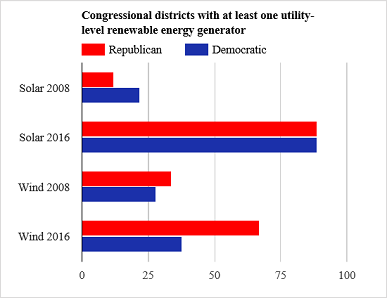With clean energy jobs booming in Republican districts, time to recalibrate climate politics?
Editor’s note: This post was updated on May 13, 2016.
Many elected officials want to solve climate change for the same reason activists do. Rising global temperatures will be a terrible burden on our children, cost our economy trillions and cause dangerous changes to the natural world.
But winning enough votes in Congress for bold policy changes also requires raw politics – and on that score, there’s an important, under-appreciated shift that may be improving our chances.
Look at the chart below, from Morning Consult. Utility-scale wind or solar facilities, employing thousands of clean energy workers, are now mostly in Republican districts.
That’s because sunshine and wind are abundant in places such as Kansas, North Carolina, Oklahoma and Texas. And rural areas, often represented by Republicans, have inexpensive land available for facilities like this.

Courtesy of Morning Consult.
Clean energy jobs, in other words, are no longer partisan or regional, if they ever were. Texas leads the nation in wind. North Carolina and Nevada are hot beds of solar energy.
This is important because there are very few things politicians care about more than their constituents’ jobs. In fact, job stability and growth are the lens through which they see nearly every issue.
Nationwide, solar jobs have grown 20 percent annually for the last three years. There are now far more jobs in that industry than in coal mining, and most new electric generating capacity added last year was renewable.
Red states and congressional districts are on the receiving end of a large chunk of that growth.
So it could be that next time Congress considers comprehensive clean energy and climate legislation, the terms of the debate will be different. This time, the “jobs argument” would come from a bi-partisan block of politicians representing clean energy workers with real jobs.
And that might just change the whole conversation.











